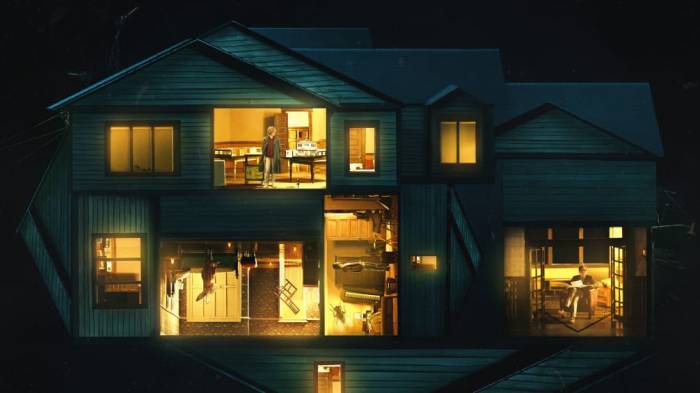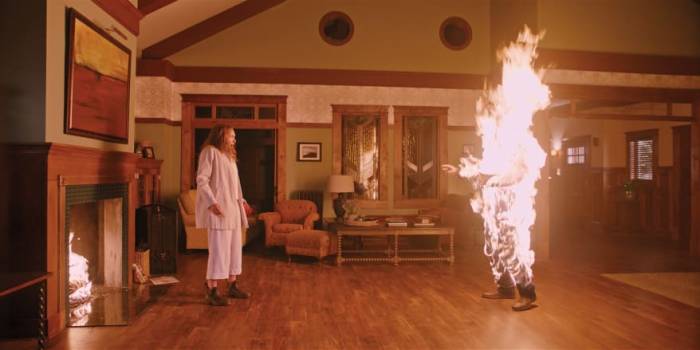
"Hereditary" -- Ari Aster's debut feature has shot into headlines as arguably this year's scariest movie. Underpinning the drama is a disturbing family home where misdeeds abound and tensions -- domestic and supernatural -- run high. It's indebted to a long line of spooky houses on screen. Scroll through to discover CNN Style's top picks. Credit: A24
The camera moves on, but the mise en scene is established. The uncanny is turned loose, the real and the phantasmagoric emulsified. These characters are the playthings of some external force, the setting a willing conspirator. Home is where the horror is.
Such ideas are not new to the genre, and whether it wants to admit it or not, Aster's film is the convergence of so many of horror's expressions of the domestic sphere. To speak nothing of the plot (and it's best not to) the writer-director exploits everything from Greek tragedy to Gothic literature to 1980s slasher flicks, with dashes of "Rosemary's Baby," "Don't Look Now" and "The Shining" all stirred into his nightmarish cocktail.
Revolving around a stay-at-home artist untethered by grief, Toni Collette's performance is receiving early Oscar buzz. But every actor needs a stage, and the one conjured by production designer Grace Yun deserves attention -- it too is a character in its own right.
The family home is a profoundly unsettling space, even if we have seen some of these ideas before. This familiarity begs the question: why are we still so scared? And secondly: why do we keep coming back for more?
No safe spaces
French philosopher Gaston Bachelard writes in "The Poetics of Space," "If one would ask us what is the most precious benefaction of the house, we would say: the house accommodates dreaming, the house protects the dreamer, the house allows us to dream in peace."
It follows that if peace and protection is stripped away from the house, it presents something of an existential crisis to its occupants. (Darren Aronofsky's "mother!," cloaked in grandiose allegory, had this simple idea at its heart.)
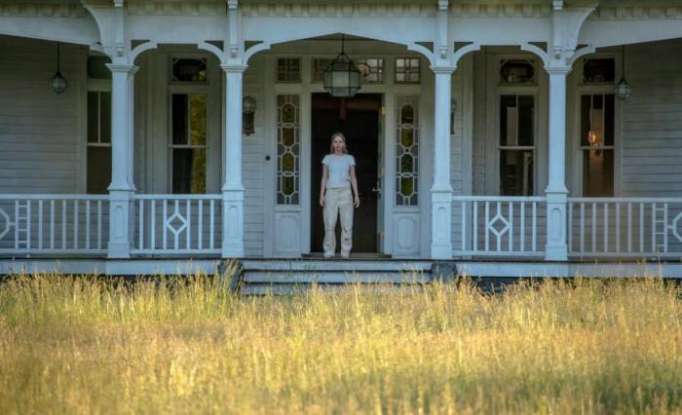
In "mother!" Jennifer Lawrence faced a host of unwelcome guests, who derailed her home makeover with disasterous consequences. Credit: Niko Tavernise/Paramount
However it manifests, we all fear a loss of control over our perceived safe space. But perception is both subjective and objective. Some question whether homes can ever be safe spaces -- none more gleefully than "the master of suspense" himself, Alfred Hitchcock.
In 1965 Hitchcock famously quipped that "one of television's greatest contributions is that it brought murder back into the home, where it belongs." The director's aphorism rings true -- homes are, in many ways, brimming with violence.

The killer in "Scream" (1996). A classic case of violent crimes committed by persons close to the victim. Credit: Dimension Films
"They're places rife with tension: psychological violence, emotional violence, and in some cases, literal violence," said Mark Jancovich, professor of film studies at the University of East Anglia. "We imagine (violent threats are) external, we want to believe they're external, but actually they frequently bubble up from within."
"We may be locking ourselves in with the very people we should fear most," he added, chillingly. Statistics bear this out. In the US between 2005-2010, strangers accounted for only 9% of violent crimes committed in the victim's home.
In any case, we still want to believe our house is a safe space. Horror films set in homes actually might help us in this regard.
There's an argument that watching scary movies is cathartic: a consequence-free simulation of our worst anxieties and fears. The experience is stressful, but ultimately rewarding given that when the credits roll we can return to reality unscathed. Aristotle might suggest the catharsis helps us explore and understand our fears, and so when we think about our home, we can use this knowledge to assert a sense of control back over it.
Yun says she suffered nightmares while crafting "Hereditary's" domicile. In theory at least, they weren't for nothing.
Out of sight, not out of mind
It may take a while to convince audiences the film is a positive mental experience. Nevertheless, viewed through this lens the home becomes a switchboard, and there's plenty of ways Yun and Aster can plug into our fears.
The Graham family's 20th-century house is rural enough to evoke Gothic mansions but built with a modern sensibility. Its interiors, with wood-paneled walls and cast-iron bedframes, is a stately home on a suburban budget. Outside a treehouse perches in isolation, the cabin not quite in the woods.
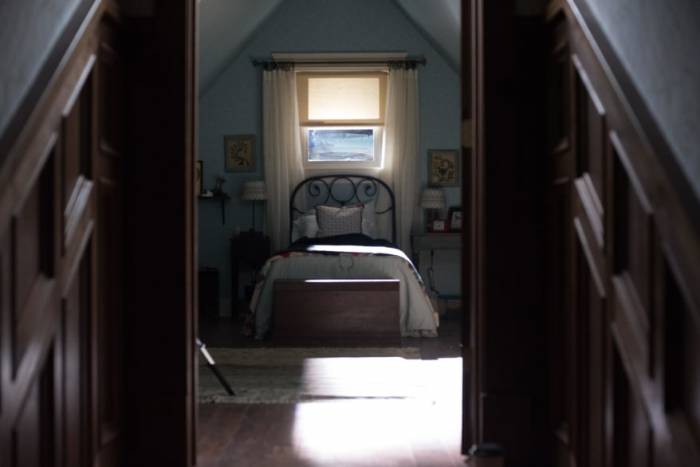
The bedroom belonging to Charlie, Annie's daughter. Credit: Reid Chavis/courtesy of A24
"(Ari and I) didn't want it to look decrepit," said Yun in a phone interview, "we wanted it to ride the line of believability." At first glance the place is, but the devil's in the detail. Annie's deceased, ornery mother once lived in the house. Her influence has seeped into the timber, and echoes unsolicited down the maternal line.
Legendary director Dario Argento has argued that "without psychology, the horror film doesn't exist." Grief is as much a source of horror as the paranormal in "Hereditary," and both are reflected in the design. Annie's studio is filled with miniatures of her home life, real and imagined, life-like scenes as accurate as they are disturbing. "As an artist (they're) her way to process traumatic events -- events that are unresolved for her," said Yun.
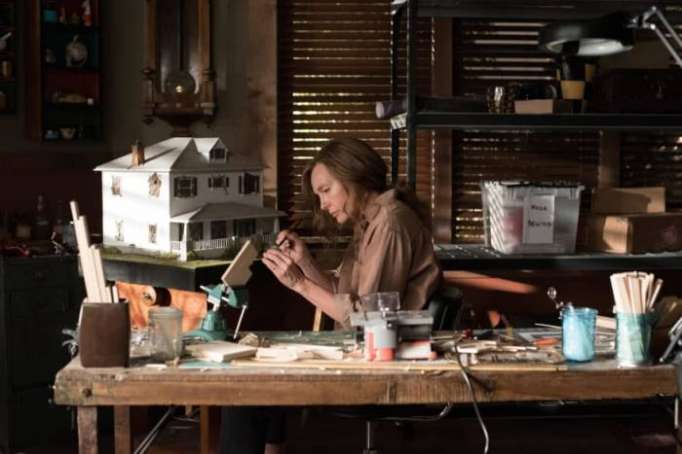
Toni Colette as grieving artist Annie works on a minature in her at-home studio. Credit: Reid Chavis/A24
The domestic dioramas she makes spill out into the full-scale home. Yun researched dolls' houses and noticed the way each room had its own defined aesthetic -- color schemes, wallpaper patterns and symmetry. Reverse-engineering the house, she subtly made sure "each room had its own unique aspect to it."
It helps audiences navigate the space, Yun explained, but also offers a sense "you're trapped inside Annie's artwork." Freud's literal translation of the German "unheimlich," from which the uncanny derives, is "unhomely." Both are apt descriptions for the effect Yun creates.
Curiously, Yun admitted she's "not well-versed" in the horror genre. "Ari thought my ignorance was somehow a benefit," she said, given he "didn't want a photocopy" of what was already out there. It's interesting -- and perhaps speaks to something unconscious -- that the way Aster uses the house, constructed to accommodate his 80-page shot list, evokes some genre staples.
Over 100 years of scary movies have codified home interiors. We know from "Psycho," "The Silence of the Lambs," and recently "Get Out," that entering basements is a fraught with danger. Attics are zones of perilous discovery for trespassers ("The Innocents"), and a space where occupants confront uncomfortable parts of themselves ("Jane Eyre").

Ted Levine as Buffalo Bill, the serial killer in "The Silence of the Lambs," who skinned his victims in a basement workshop. Credit: AF archive/Alamy
In life, so in horror cinema, "you need a sealed off space," said Jancovich. We can't live among everything we own, he argued, and we choose what to put on show. Thinking of the house as a metaphor for the brain, there are peripheral spaces where we push possessions -- or memories or thoughts we don't want to confront but can't let go of -- out of sight and out of mind. Combined, these spaces can become a repository for our fears.
Through repetition of space and symbol, the genre does a lot to reinforce its own visual language. In "Hereditary," as Annie hovers in front of her mother's bedroom door, we know without prompting that no good can lie behind it.
That's not to say Aster's film isn't original, or its home not subtle. For instance, the way Yun fleshes out the character of Annie's reticent daughter Charlie (Milly Shapiro), with an outré studio of her own, is a twisted delight which invites close inspection and spawned its own Etsy page.
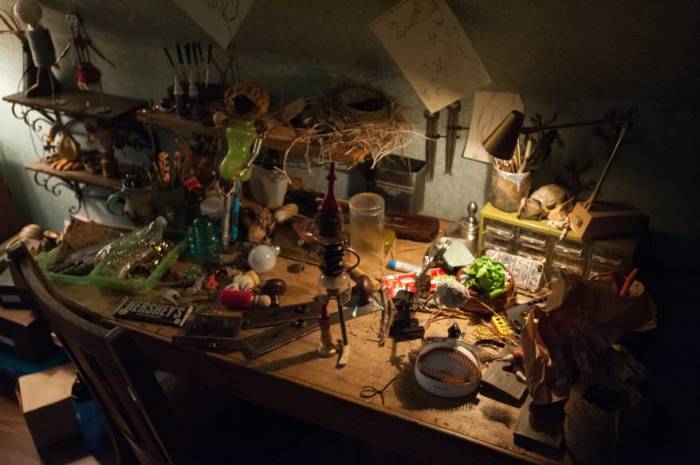
Charlie's workshop, where she crafts figurines from salvaged goods -- including dead animals. Credit: Reid Chavis/courtesy of A24
"(Aster) loves films that, when you go and watch it again, you discover something new, you discover another layer," said Yun. Her production design is full of details and motifs that will only register on a second or third viewing. Annie's other miniature houses dotted around the home deserve scrutiny, for one. "I don't want to give too much away," she said, "but all that stuff was thought about, for sure."
"This design was trying to be evocative," Yun reflected. "I feel like I did birth something at the end," she added, "it was cathartic in a way."
Yun may feel purged, but audiences have all that to come. Her baby, that house, lies in wait, ready to welcome its next victims.
CNN
More about: movies








